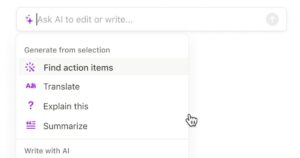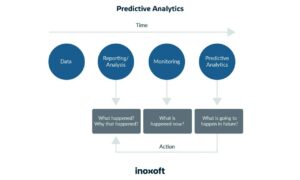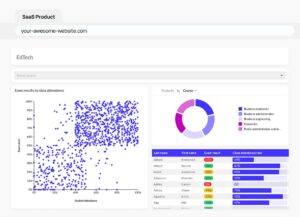Do you think creating content the old way is still enough in today’s digital world? With AI becoming more advanced, every marketer needs to leverage AI. These tools not only help you generate content but also optimize it for better conversion. Content creation with embedded AI allows for more efficient processes and tailored outputs. You can tailor your content with AI so that it resonates better with your audience and has a bigger impact. Plus, AI makes it easier to understand data and predict trends, making content creation faster and simpler.
Whether you’re a fan or a skeptic, there’s no way to deny the potential of AI for content creation:
- Nearly 35% of businesses have already adopted AI solutions
- 77% of consumers engage with AI solutions, even if they don’t realize it
And here’s one of the major reasons for the technology’s success: rather than having a life of its own, AI is incorporated into other popular tools to make the process easier and faster.
That’s what we call embedded AI. Let’s dive deeper into its definition, potential, use cases, and significance for content creation.
Understanding Embedded AI
What is Embedded AI?
Embedded AI stands for the process of integrating AI algorithms and models into existing hardware devices or software systems.
In other words, embedded AI is designed to be a personal, data-driven assistant integrated into the devices or software you use to handle everything from content generation to optimizing your content strategy. It allows automated content creation by using AI to deliver personalized and high-quality solutions.
Imagine a fitness tracker that adapts to your activity and gives you recommendations, or project management software that creates summaries of reports in real-time.
With generative AI for content, it can streamline your digital marketing efforts by producing AI-generated content that enhances your brand’s presence, from visual content to natural language applications. Content creation with embedded AI further supports this by integrating AI directly into the creative process. AI plays a key role throughout the content creation lifecycle, helping you optimize content across platforms, ensuring it resonates with your audience. With AI, you can combine human creativity and automation, revolutionizing the way marketing content is produced.
What Makes AI So Good?
At its core, Artificial Intelligence is designed to automate and perform tasks that usually need human input. AI systems utilize various approaches to collect and analyze data, enabling them to behave in a human-like way. Advanced AI and AI technologies are now being used to enhance content creation, especially on social media platforms. Content creation with embedded AI further elevates this process, providing seamless integration of AI tools into content workflows. AI solutions offer significant advantages of embedded AI, such as content optimization, customization, and improved output for content marketers. By using tools like AI, you can make your content more engaging and effective. AI can be a powerful tool throughout the content creation process, allowing you to make content faster and with greater precision, while still maintaining human oversight. Whether it’s to enhance content or to automate tasks, AI to create content is transforming how we approach content optimization.
AI systems use many approaches to collecting and analyzing data, including:
- Machine Learning (ML) is a system that automatically learns and improves from the amount of data they consume without external help or navigation from humans.
- Rule-based logic, or predetermined data training systems, tries to follow and copy people’s decision-making logic when performing tasks.
- Natural Language Processing (NLP) and Computer Vision, or systems that rely on advanced ML techniques to recognize and extract human speech or images
- Generative AI (GenAI), or systems trained to retrieve and produce information based on the data they analyzed
Whether by building custom AI or ML systems for your website or software or by embedding existing open-source AI systems into your solution, the objective should always remain the same: taking the hassle of routine tasks out of the process. Because that’s what makes AI worth your resources.
Software Vs. Hardware Embedded AI
Based on your goals and methods of using AI for tasks and operations, you can distinguish between hardware and software-embedded AI.
Hardware-embedded AI means that algorithms are directly integrated into specialized hardware components.
On the other hand, software-embedded AI is about integrating specific algorithms into specific applications (think desktop apps of a SaaS solution) without the need to perform tasks outside the software.
Despite the distinction, the most common use of embedded AI today is a powerful combo of both. For example, embedded software development services combine strong software and hardware to make sure it has the capacity to handle large data sets, while on-device embedded AI proves maximum efficiency.
Let’s look at some examples of both approaches.
Examples of Embedded AI
There are several use cases of embedded AI that people are quite used to in their daily lives, like fitness trackers or smart fridges. But today, the hardware industry has gone beyond simple integration.
For example, earlier this year, DeRUCCI announced its Smart Mattress, an AI-empowered mattress capable of detecting health issues based on sleep data:

AI Mattress by DeRUCCI
Another example that drew the tech world’s attention this year was the introduction of AI Pin by Humane. Essentially a wearable AI-powered device, it uses speech recognition and a camera to perform all the tasks you use the phone for. Without using the phone and looking at the screen.
Just look at how the device can use your hand as a display:

AI Pin’s “hand display,” powered by Humane
When we’re talking about software-embedded AI, the examples are basically endless. Virtually every software solution today has integrated AI in one way or another to benefit the user. Let’s look at some great use cases in other industries:
Productivity & Project Management.
Notion, a top note-taking and project management software, integrated AI into their solution to act as a personal assistant that analyzes the notes, generates text, and categorizes the content to give an entirely new meaning to “productivity.”

Notion’s AI assistant.
Graphic design & Illustration.
Adobe has presented its native GenAI, Firefly, as a visual editor with diverse functionality, including image augmentation, item remover, and image generation:
Lightroom’s Generative Remove, powered by Firefly.
Security & Identity Verification.
Since bureaucratic processes are often associated with long waiting times and numerous obstacles in the way, an identity verification platform with EAI can help speed up the process by accessing large datasets with background information and retrieving all the necessary information about an individual:

Example of an identity verification platform.
Considering the number of emerging solutions that embrace EAI, the technology has great potential to make people’s lives easier. But what about other pros and cons associated with AI?
Benefits of Embedded AI
Real-Time Data Processing
Rather than taking time to consume and analyze data (like we all do), EAI is trained to perform the action with minimal delay. Because of its systematic nature, embedded AI quickly recognizes the input and connects it to the action you want it to perform.
Personalization & Customization
Embedded AI can be fed any kind of training data to ensure it produces the most relevant content like responses or social media posts.
For instance, if you’re working with a company-wide AI assistant, you can supply it with all the important documents and knowledge bases related to your business. The capabilities of AI, such as natural language generation and natural language processing, will allow it to provide quick, custom answers based solely on the information you want it to process. Content creation with embedded AI can further streamline this by seamlessly integrating AI into your workflows. AI allows you to automate and enhance your content creation, and with the excitement around AI, there’s a growing demand for AI to personalize content across various platforms. By integrating AI strategies, businesses can leverage AI capabilities to improve content performance across different mediums, ensuring that AI will make your content more relevant and impactful.
Predictive Analysis
Thanks to the ability to process large amounts of data, embedded AI has enough knowledge to recognize performance patterns and make data-driven forecasts.
If we’re talking about NLP systems, the predictions can go as far as recognizing and anticipating user preferences based on historical data (their previous interactions and requests).

Predictive analysis model. Source: Inoxoft
Scalability
With enough training and data, embedded AI models can easily adapt to the needs of your business or users, whether it’s processing larger data sets or changing the approach to analyzing and categorizing the information you give it.
Improved Functionality
The power of automation helps you add an array of duties and responsibilities that can’t be done by a human being.
For example, if earlier, you had to manually gather and analyze historical data to make a report, embedded AI can do it in seconds just by gaining access to your dataset and receiving the right instructions.
Challenges of Embedded AI
Extensive Data Collection
While AI is all about data, feeding it all the data you can find is not an option. To make the system work, it’s important to secure rule-based logic for your AI and find the right data to train it on. Content creation with embedded AI benefits from this approach by ensuring the AI is trained on relevant data, improving the accuracy and effectiveness of the content produced.
Otherwise, EAI solutions can hallucinate or give inaccurate information, so you will have to find the sources of quality data and set the standard for consuming and processing it.
Security
Since AI needs a lot of sensitive information to produce precise answers, the data can easily be compromised because of weak AI security.
For example, if you’re embedding an AI model into the hardware without knowing how it was built, tampering with one device is enough to take over the whole system.
User-Friendliness
As more companies start to use data to train AI models, more users start to express their concerns about the security of their data.
Unless you’re 100% transparent on how embedded AI interacts with user data, you might face both regulatory violations and user churn.
The pros and cons above apply to all the EAI models, and there’s much food for thought for anyone trying the tech out. Content creation with embedded AI is a prime example of how this technology can be applied to streamline processes and improve outcomes. But it’s safe to say that the future of embedded AI and the efficiency it brings is nothing but promising.
Let’s take a closer look at embedded AI in one of the industries we know a lot about: content creation.
Embedded AI in Content Creation
EAI in content creation is all about powering up your creative flow with real-life recommendations and content marketing ideas. Think of embedded AI as your brainstorming buddy for coming up with ideas and implementing them on the go.
Here are just a few examples of how EAI is meant to support the content creation process:
Text Generation
Writing Assistant
There’s nothing scarier for the content creator than staring at a blank page.
Embedded AI solutions in writing applications are designed to:
- Research a specific topic before you start writing
- Give you a list of ideas to start with
- Continue writing where you left off once you’ve hit the writer’s block
To make sure it’s mimicking a specific style, train the AI with samples of the actual writing you did.
There are many helpful tools you can use, depending on your objective. These tools include a short story generator, a speech generator, a prompt generator, and more. For example, the AI Blog Post Generator could be a perfect addition for content creators who manage a blog.
Editor
Rather than waiting for a few days to come back to your material and spot the mistakes, let the AI do it for you by checking your spelling and style.
For example, embedding a Grammarly AI tool into your mobile can easily adjust the message or text to the style and emotion you’re looking for.

Grammarly’s AI mobile editor.
Summarizer
Thanks to the AI’s ability to process large bits of information, you no longer have to go through tons of research or come up with snippets and summaries for your writing.
Embedded AI solutions allow you to find the most relevant points in large source files. And when it comes to your writing, you can easily summarize your text for an AI-written blog introduction or meta description without re-reading the content a dozen times.
Video & Audio Generation
Whether you’re a full-time creator or a business leader working on a personal brand, various software solutions offer embedded AI models to instantly interpret and edit the raw files. Content creation with embedded AI enhances this by providing more efficient tools to refine and optimize content automatically.
For example, embedded AI solutions in video-recording software like Riverside can automatically create clips for social media, normalize audio levels, and cut pauses between words.
Content Curation
For a user, it’s easy to get lost in the sea of content and find some real gems.
For a business leader, it’s easy to lose your client in the sea of content and show them you have some real gems.
Both scenarios can be easily resolved by embedded AI that can recognize the keywords searched by the user and show similar curated content based on the data.
Localization
If you’re a digital creator, Content creation with embedded AI is a great way to share your project with more people.
By embedding an AI localization tool, your project (online portfolio or an app, for example) is easily translated into other languages via over-the-air technology.
Data Visualization
If you want to step up your Content creation with embedded AI, turning data and research into interactive dashboards is definitely a great choice. Embedding AI-powered tools into web applications like your blog can help you convert attention and build a recognizable brand.

AI-powered dashboard example. Source: Luzmo
Social Media Content Creation
Distributing a piece of content throughout all the social media channels has never been easier.
Right now, all you have to do is choose a content management software with embedded AI tools and instantly turn an article into:
- Short social media teasers
- AI-powered YouTube voice-over videos
- Podcast clips
All you need is a high-quality piece of content to play around with. And we already know AI can help with that, too.
It really seems like you can do anything with AI.
Is it actually great, or is it a sign to stay alert?
The Future of Content Creation with Embedded AI
The past couple of years have shown us that AI is here to stay. However, this is not something to fear, but an opportunity to embrace. While some creators are worried about AI taking over their jobs, ethical use of AI, like AI writing tools, is designed to assist rather than replace. Content creation with embedded AI is part of this assistance, seamlessly integrating AI to enhance workflows without replacing human creativity. These tools can help with mundane tasks such as editing and proofreading, freeing up more time for creators to focus on the creative aspects of their work. AI enhances content production and content personalization, ensuring content tailored to your needs resonates with your audience across multiple platforms. With AI content creation, you can improve content delivery for different content types like blogs, articles, and social media activity. While AI helps automate various forms of content, it’s important to remember it’s not a replacement for human creativity. Staying updated with AI-powered tools and platforms will help you stay ahead of the curve in the evolving content space.
So, to sum it all up…
Content creation with Embedded AI is a great way to speed up tasks and give people more time to do something meaningful.
And that’s really evident in the context of content creation: Right now, you can do anything from podcast hosting to creating digital art without the need to go through hours of footage or spend a decade studying how to remove objects in Photoshop. Content creation with embedded AI makes these tasks even easier by providing tools that integrate directly into your workflow, streamlining the process and enhancing efficiency.
And there’s nothing more exciting than opening a whole new world of opportunities.
Even if ideas like Content creation with embedded AI seem confusing and complex at first, once you get to know how the system works, you won’t go back to doing things the old way.


